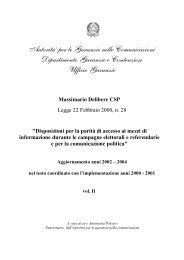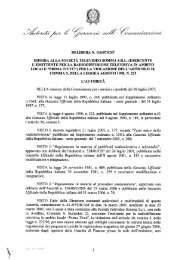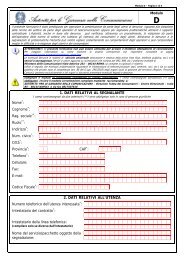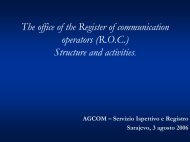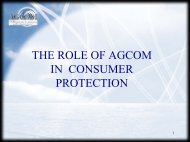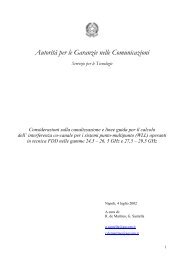Communications Regulatory Authority
Communications Regulatory Authority
Communications Regulatory Authority
You also want an ePaper? Increase the reach of your titles
YUMPU automatically turns print PDFs into web optimized ePapers that Google loves.
handset use restrictions when the SIMlock is activated, the value of the applied subsidy,<br />
the cost of the de-SIMlocked handset, the SIMlock activation term, and the methods to<br />
remove the SIMlock once the term is over. With regard to taking-out methods, a<br />
separate and special information fact sheet shall be used subject to explicit acceptance<br />
by the customer.<br />
As regards applicability limits, AGCOM prescribed that SIMlocked handsets<br />
shall be de-SIMlocked after 9 months, upon the user’s request, upon payment of an<br />
amount not exceeding 50% of the value of the subsidy granted by the operator at the<br />
time of the purchase, and, in any case, free of charge at the end of an 18-month period.<br />
With regard to the handset full operating capability guarantee at the end of the<br />
SIMlock term, the communications service provider offering handsets shall guarantee<br />
that the latter, once deactivated, can work with all mobile networks with no limitations<br />
in terms of effectiveness and services.<br />
Supervisory action as regards compliance with the current regulation on<br />
mobile number portability<br />
Mobile number portability (MNP) among mobile and personal communications<br />
service network operators enables users who decide to switch to another operator for the<br />
provision of mobile, voice and data services to keep their telephone number.<br />
Since early 2005 an increase has been reported in applications for mobile number<br />
portability. To that end, AGCOM has encouraged operators to enter into an agreement<br />
under which, since 31 August 2005, each operator has increased the maximum number<br />
of applications that can be processed on each working day, so causing an increase from<br />
5,000 (as from 26 April 2004) to 5,700 (as from 31 August 2005), and later to 7,500 (as<br />
from 17 October 2005) in the number of portability transactions carried out.<br />
AGCOM’s monitoring action later highlighted a significant delay in the<br />
processing of portability applications, in particular by Telecom Italia and Vodafone<br />
towards H3G, as for the relevant applications the processing capability provided by<br />
these operators proved insufficient. This brought about a protraction in the service<br />
provision time. As a consequence, by means of Resolution no. 17/06/CIR, AGCOM<br />
decided to further increase the processing capability by setting it to 9,000 daily<br />
transactions. This Resolution also provided for the undertaking of initiatives aimed at<br />
making additional processing capabilities available in order to process portability<br />
applications left outstanding by Telecom Italian and Vodafone towards H3G.<br />
AGCOM also took action by requiring the adoption of precise processing<br />
methods, in order to assure that the correct order be kept in handling applications.<br />
By April 2006 more than 8 million users had switched to another operator while<br />
keeping their telephone number. Approximately 45% of migrations have occurred over<br />
149




